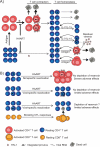From reactivation of latent HIV-1 to elimination of the latent reservoir: the presence of multiple barriers to viral eradication
- PMID: 23613347
- PMCID: PMC4386637
- DOI: 10.1002/bies.201200170
From reactivation of latent HIV-1 to elimination of the latent reservoir: the presence of multiple barriers to viral eradication
Abstract
The discovery of a stable latent reservoir for HIV-1 in resting memory CD4(+) T cells provides a mechanism for lifelong persistence of HIV-1. The long-lived latently infected cells persist in spite of prolonged highly active antiretroviral therapy and present a major barrier to a cure of HIV-1 infection. In this review, we discuss the current understanding of HIV-1 persistence and latent viral infection in the context of effective antiretroviral therapy and the recent progress in purging latent viral reservoirs. Recent studies demonstrate that reactivation of latent HIV-1 is a promising strategy for the depletion of these viral reservoirs. A thorough evaluation of the anti-latency activity of drug candidates should include the measurement of changes in intracellular viral RNA, plasma virus levels, and the size of latent viral reservoirs, as well as potential adverse effects. Currently, there are several technical barriers to the evaluation of anti-latency drugs in vivo. We also discuss these challenging issues that remain unresolved.
© 2013 WILEY Periodicals, Inc.
Figures


References
-
- Perelson AS, Essunger P, Cao Y, Vesanen M, et al. Decay characteristics of HIV-1-infected compartments during combination therapy. Nature. 1997;387:188–91. - PubMed
-
- Dornadula G, Zhang H, VanUitert B, Stern J, et al. Residual HIV-1 RNA in blood plasma of patients taking suppressive highly active antiretroviral therapy. JAMA. 1999;282:1627–32. - PubMed
-
- Havlir DV, Koelsch KK, Strain MC, Margot N, et al. Predictors of residual viremia in HIV-infected patients successfully treated with efavirenz and lamivudine plus either tenofovir or stavudine. J Infect Dis. 2005;191:1164–8. - PubMed
Publication types
MeSH terms
Substances
Grants and funding
LinkOut - more resources
Full Text Sources
Other Literature Sources
Medical
Research Materials

